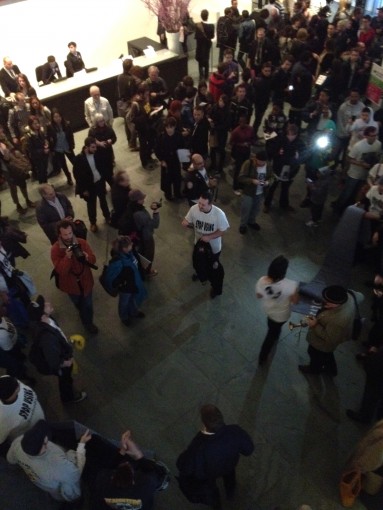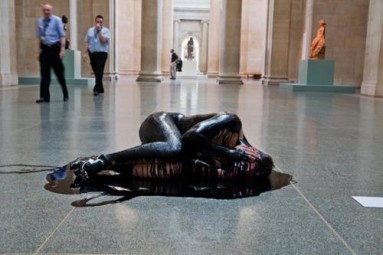'The Streets Are Dead Capital'
Recently I went to a talk by Ricardo Dominguez, an artist and hacktivist I had the occasion to interview a year ago. To say that Ricardo gave a 'talk' is putting it mildly. What you get with him (a trained actor) is more a passionate and self-conscious oratory performance than a scripted dry-run; as if to underscore this point, tucked underneath his lecturer's day clothes was a Superman t-shirt, giving the unsettling illusion that at any moment the bespectacled stand-in for Clark Kent was going to transform into a caped crusader.
His starting point: design is a marker and site for neoliberal markets. One might choose to read 'design' broadly as self-enclosed, highly produced spaces, ergo your basic mall, museum, amusement park, or sports arena.
If design is a repository for obscured market power, Ricardo reasoned, then those lacking power could intervene with 'microgestures' that allow power to stage itself. In 1985 he performed such a microgesture at a site he viewed as part of an 'exit culture' of Disneyfied commodity exchange. He bought various packaged commodities—toys and electronics and so forth—but instead of going home he opened them at the exit door of a mall and began displaying and playing with them. Soon a crowd would gather, which inevitably set off mall security and then the police.
The kind of person who acquires packaged goods but doesn't go home is typically a war vet, drug dealer, or homeless person, all of whom invite police attention because they are perceived to be trespassers. Bodies that deny the process of flow—by now it is as common to hear move along, there's nothing to see here in colloquial form as it is to read it in a volume of French theory—are considered a blockage. Ricardo's body became an instant site of blockage as a community of people formed around him at precisely the designated exit point at a shopping mall. He describes this—completely seriously, I might add—as an act of sabotage, accounting for the origin of the word 'saboteur' as women factory workers who wore wooden sabots at the mill so they could stick them in the machines (Fr. saboter, 'kick with sabots, willfully destroy').
During the Industrial Revolution, machines replaced workers at an alarming rate throughout Europe, and the once stable economy of guild and craft shop members who had performed manual labor for generations found their very welfare threatened. To protest machine replacement of workers, the workers would toss their shoes into the machine works to make them stop—sabotage.
Since his work in the 1980s with the Critical Art Ensemble and the Electronic Disturbance Theater Ricardo and his cohort have explained streets as dead capital. The streets' primary design is to aid the flow of people and traffic, and even minor blockages such as the mall exit experiment are bound to perk up the antenna of even the laziest squad patrol. If flesh-and-blood bodies are being subjected to unprecedented curbs on freedom of movement and assembly, then a virtual alliance with data-bodies retains the possibility to return some power back to the disenfranchised: '[W]e put forth our idea that all digital actions must be part of parallel street action. That via transparency and simulations data bodies and real bodies could act in unison.'
This seems inarguable, especially given how (1) activists have at least since the 2004 DNC and RNC conventions coordinated their real-bodies via TXTMobbing, a technology developed for communicating and reporting in real-time in 160 characters, a direct predecessor to Twitter, Inc., and continue to do so on an exponential level, (2) popular awareness about virtual networks of hackers, hacker cultures, and the liquid potential of the web (e.g. Anonymous, LulzSec, Wikileaks) seems more diffuse than ever, and (3) allegiance and retaliation for the wrongs done to real-body activists by police, the FBI, the Justice Department, among others, have often been exacted by data-body activists—in fact, sometimes those wrongs are so egregious and the inculcated parties so powerless that appealing to collectives like Anonymous has became a foreseeable form of real-body/data-body solidarity.
'An Emergency May Happen'
Last month I went to see 9 Scripts from a Nation at War at the Museum of Modern Art. I arranged a press pass in advance of my visit. But admission to the museum is free on Target Free Friday Nights. No one cared about the press pass, and I headed to the installation gallery.
One of the screens showed a reenactment of a testimony by a female American soldier in Iraq. I took the kind of careful notes that come with the realization of how glazed, distracted, and unreliable your mind becomes in the crowded and hot crush of museum-goers.
I like some of the Iraqi people.
You don't know who is against you, who is for you.
I felt I was maintaining the country, not defending the country. What are we truly defending.
When you have your uniform on you get a totally different feeling. It's like a switch.
I was startled out of the note-taking by a clamor. I ignored it, but it grew persistent. It was the kind of sound you imagine hearing if two very wealthy people started fighting over the last Knoll Tulip Chair in the museum gift shop. The clamor swelled to a roar.
I rushed outside toward the glass balcony, where tens or maybe hundreds (it would certainly become hundreds) of people were starting to hover. Mic-check! There's no adequate way to describe what it feels like to walk into a political action at an art museum you had nothing to do with. That's exactly how someone responded when I blared the horn on Twitter: the actions are becoming so prevalent that people are literally walking into them.
The wave of mic-checks alerting watchers to MoMA's ties to Sotheby's—the main target of the action—continued for some time without a police intervention. Presumably private security was calling them, since that's what private security does when a group of people shout in unison in an encased space.
I fumbled with my phone camera and started recording, capturing one of the first waves of mic-checks just before a hefty security guard stood in my way and pushed me off the balcony rails. I shouted at him to stop and demanded his name. He elbowed more people out of the way and poked a IO PARLO ITALIANO badge into my face.
Much more surprising than getting pushed around by museum security was the realization that an institution devoted to procuring objects for people to look at was actively blocking their view of a live event, happening in front of our very living eyeballs. By the time a second, third, and fourth wave of mic-checks started, the upper-level balconies of the museum were completely cleared of people. I started recording again. This is when a MoMA floor manager appeared. When I asked why he and the security guards were shooing us away and preventing us from watching he said very austerely, 'An emergency may happen.'
On the ground level of the museum the mood was buoyant. Art handlers from Local 814, transit workers from Local 100, communication workers, carpenters, and NYU students mingled, giving the illusion of a temporary freehold of the space. The museum's Free Fridays, a student explained, provided them with a 'ready audience' for the actions, bringing to mind the curious and surefire swarm toward Ricardo's exit displays in the '80s.
'Union-busting' does more to onomatopoeically evoke a police gang bursting through a union hall than to offer a realistic description of how contemporary unions actually get dismantled. It's more a war of attrition than a stealth bomb attack. Like other prominent union battles (such as public school educators in the United Federation of Teachers, or New York state workers under Governor Cuomo) Sotheby's union-busting tactic includes instituting a two-tiered system (or as someone described to me more evocatively, a 'two-headed beast'). New hires were due to make about half the salary of veteran workers. When the Teamsters resisted, Sotheby's locked them out for eight months.
From Sotheby's: Bad for Art:
In 2010, Sotheby’s sales increased by 74 percent to $4.8 billion. And recently, Sotheby’s reported its most profitable quarter in the company’s 267-year history. Despite record profits and growth, Sotheby’s refuses to negotiate a fair contract with its art handlers. Instead of recognizing and rewarding the contribution these workers have made to the company’s success, Sotheby’s has locked out its professional art handlers, kicking them into the street with no paycheck, while outsourcing their jobs to temporary workers. Meanwhile, Sotheby’s rewarded its CEO by nearly doubling his annual salary to almost $6 million.
That the workers' fighting Sotheby's, who personally faced the expiration of their healthcare coverage, displayed this kind of sincere worry about the art works at the expense of their own livelihoods makes the art conglomerate appear especially insidious:
Is Sotheby’s putting irreplaceable and fragile pieces of art at risk? Auctioneers may sell the art, but art handlers are responsible for the transportation, preparation and display of each piece. Some of the locked out art handlers have more than 40 years of experience protecting art that sells for as much as $100 million. Replacing these individuals with temporary workers is enough to make anyone scream.
Neo-Situationists?
Situationism, as outlined in Guy Débord's La société du spectacle (1967), Raoul Veniguem's Traité du savoir vivre à l’usage des jeunes generations (1967), the May 1968 brochure ‘De la misère en milieu étudiant, considerée sous aspects économique, politique, psychologique, sexuel et notamment intellectuel et de quelques moyens pours remédier,’ and in the 12 journal issues of the Internationale Situacionniste (1958-69), settles on a short but indispensable principle: a fight against the spectacle, the culture of the spectacle, generalized spectacularization, or against non-participation and non-intervention against passivity and social alienation.†
The rousing Situationist call to dérive or drift and to disorient oneself in familiarly designed surroundings did not obligatorily carry political overtures, but doubtless the principle they had in mind was to be used in an ongoing life project rather than a one-time edict. Either the political disruption and social transformation they imagined worked so organically that one could simply drift in and out of them or the reception to Situationist ideas has interpreted them that way.
We might want to spend a night in a house that's in the process of being torn down or hitchhike without a destination through Paris during a transportation strike—just to add more confusion—or break into graveyards and catacombs, wandering aimlessly through the bones.†
On 16 April 2012 University of Vermont students mic-checked UVM Board of Trustees member and Sotheby's Arthouse CEO Bill Ruprecht.
Bill Ruprecht
Is paying himself
6 million dollars
And recording record profit at Sotheby's
All while locking out his art handlers
In order to force cuts in wages and healthcare
Bill Ruprecht's actions are in contradiction
To the values of UVM
Before you go into debt
At one of the most expensive
State universities in the country
Demand that Bill Ruprecht
Settle up with his workers
Or step down from the Board of Trustees
The activist group Liberate Tate drenched themselves in an oil-like substance and lay on the floor of the museum's classical sculpture gallery in protest of Tate’s ongoing partnership with BP. Taking place on 20 April 2012 to mark the one-year anniversary of the Deepwater Horizon rig explosion, the protest lasted 87 minutes—one for every day oil spilled into the Gulf of Mexico.
And in a moment of passing beauty that had nothing to do locking out workers or partnering with ecological destroyers (and just when you thought flash mobs had lost their power to surprise or enchant) the Copenhagen philharmonic orchestra Sjællands Symfoniorkester played Griegs Peer Gynt for unsuspecting subway passengers.
All of this happened in April of this year alone.
The odds that collectively enjoined spontaneous contestation and/or beauty will not be met with real and chilling force are almost nil (look at the blow dealt to Occupy actions, terrorism charges for anti-NATO activists in Chicago, or the crazed anti-assembly law passed in Québec) but there is another equally important certainty. Real-bodies have still not lost their ability to turn dead capital into vitalized living.



